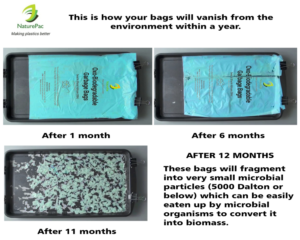Biodegradable Plastic Products are made from Hydrocarbon or fossil fuel based plastic raw
material. However, there is marginal increase in overall cost of products over the conventional
plastic products due to change in product recipe. However, these products can be recycled, reused
and even incinerated same as conventional plastic products.
The Oxo Bio Degradable Plastics are basically PE and PP but having additional elements (and not
heavy metals) designed according to ASTM D6954 or BS 8572 so as to degrade in open environment
without leaving any harmful residue that can cause a damage to environment. Our product is tested
in international Test Labs and reports can be arranged on request.
Possible applications
These plastics can be used for all the applications which a conventional plastic can suffice to.
Prominent applications include T-Shirt Bags, Garbage Bags, Plastic Mailer Bags, Agricultural Mulch
Films, etc.
Oxo-Bio Degradable Plastics Association’s official website http://www.biodeg.org/

Compostable – (also loosely known as “bio-based plastics” or “bioplastics” or “Hydro Bio Degradable
Plastics”) and designed as per EN 13432 or ASTM D6400 to biodegrade in the special conditions
found in industrial or anaerobic direction
Bio Plastics are made partly or completely from Bio mass (plants). The Bio Mass are derived mainly
from stems from plants like corn, sugarcane, potato, cellulose, etc. The Biodegradation of these
plastics happen by conversion of this material by micro-organisms to natural elements like water,
CO2 and biomass. This happens without addition of any external additive. The process of
Biodegradation however depends on surrounding temperature, location, etc.
Basic classification of Bio Plastics is;
The product complies to the international standard EN 13432 or ASTM D6400. The required test
reports are available for the testing done at the raw material level and can be provided on demand.
The end product (film, bag) can also bear an ‘Ok Compost’ mark and logo.
http://en.european-bioplastics.org/
